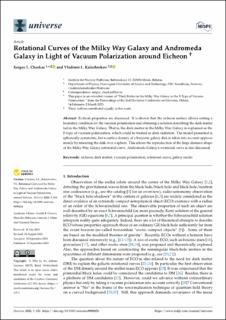| dc.contributor.author | Cherkas, Sergey L. | |
| dc.contributor.author | Kalashnikov, Vladimir | |
| dc.date.accessioned | 2024-02-28T15:26:17Z | |
| dc.date.available | 2024-02-28T15:26:17Z | |
| dc.date.created | 2023-10-10T09:15:56Z | |
| dc.date.issued | 2023 | |
| dc.identifier.issn | 2218-1997 | |
| dc.identifier.uri | https://hdl.handle.net/11250/3120358 | |
| dc.description.abstract | Eicheon properties are discussed. It is shown that the eicheon surface allows setting a boundary condition for the vacuum polarization and obtaining a solution describing the dark matter tail in the Milky Way Galaxy. That is, the dark matter in the Milky Way Galaxy is explained as the F-type of vacuum polarization, which could be treated as dark radiation. The model presented is spherically symmetric, but a surface density of a baryonic galaxy disk is taken into account approximately by smearing the disk over a sphere. This allows the reproduction of the large distance shape of the Milky Way Galaxy rotational curve. Andromeda Galaxy’s rotational curve is also discussed. | en_US |
| dc.language.iso | eng | en_US |
| dc.publisher | MDPI | en_US |
| dc.rights | Navngivelse 4.0 Internasjonal | * |
| dc.rights.uri | http://creativecommons.org/licenses/by/4.0/deed.no | * |
| dc.title | Rotational Curves of the Milky Way Galaxy and Andromeda Galaxy in Light of Vacuum Polarization around Eicheon † | en_US |
| dc.title.alternative | Rotational Curves of the Milky Way Galaxy and Andromeda Galaxy in Light of Vacuum Polarization around Eicheon † | en_US |
| dc.type | Peer reviewed | en_US |
| dc.type | Journal article | en_US |
| dc.description.version | publishedVersion | en_US |
| dc.source.pagenumber | 0 | en_US |
| dc.source.volume | 9 | en_US |
| dc.source.journal | Universe | en_US |
| dc.source.issue | 9 | en_US |
| dc.identifier.doi | 10.3390/universe9090424 | |
| dc.identifier.cristin | 2183143 | |
| cristin.ispublished | true | |
| cristin.fulltext | original | |
| cristin.qualitycode | 1 | |

